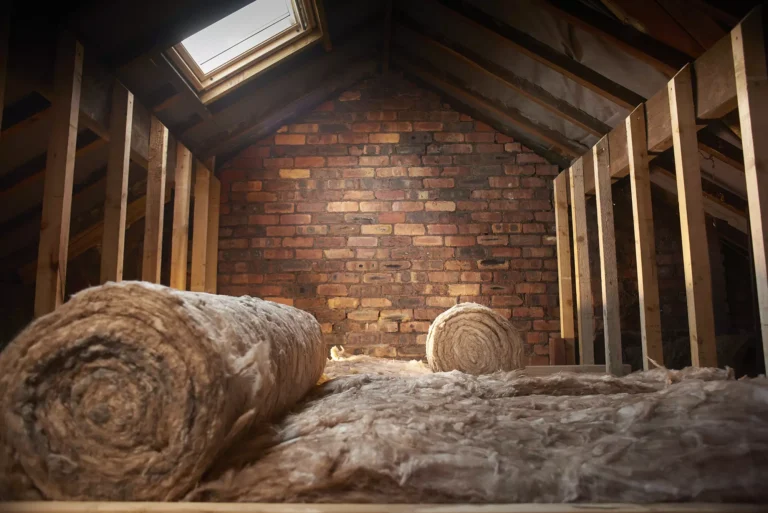
Is There Asbestos in Your Loft? What to Know Before Insulation Removal
If your home was built before the 1990s, there’s a chance that your loft insulation could contain asbestos—a hidden danger
Many homeowners have asked us about the effectiveness of recycled blown-in insulation. The fact that the effectiveness of this type of insulation depends on the specific materials used in your home.
Please note that there are different types of insulation, including various options within the blown-in insulation category, and whether or not you can reuse the insulation depends on the type used in your home.
To obtain an accurate answer to your question, it’s recommended to consult a trusted professional.
Below, we provide some useful information that may help you find the answer.
Typically, there are three types of materials used for blown-in insulation: fiberglass, cellulose, and spray-in foam. Among these three, spray-in foam cannot be recycled or reused.
Even if you choose reusable insulation, it’s still necessary to hire an expert to ensure proper and error-free insulation. Please notice that when reusable insulation is not properly installed, it can become mixed with other non-recycled materials, compromising the effectiveness of your insulation and even posing a health hazard to the occupants of the home.
To effectively utilize recycled blown-in insulation, the expert will begin by vacuuming up the existing cellulose or fiberglass. This is achieved by modifying the blower to suction the materials rather than pushing them out.
The professional insulation installer needs to ensure that the reusable insulation is debris-free, such as plaster or lumber scraps, and then refill the wall cavities with reusable materials.
If you are insulating your home for the first time, consider using fiberglass or cellulose, as they can be reused to address further insulation needs.
Pros:
Cons:
When it comes to attic insulation, you’ve got the option to use either blown-in fiberglass insulation or blown-in cellulose insulation, both of which can be reused for further insulation needs. While there are different types of insulation materials available for attics, your options may be limited if you prefer to use recycled materials.
Fiberglass insulation is formed from tiny glass fibers, installed using a blowing machine, and distributed throughout the attic.
Fiberglass materials effectively cover every nook and cranny, ensuring there’re no gaps or spaces left uninsulated. Moreover, it creates a more energy-efficient home by preventing air leaks, helping you save considerable bucks in energy bills. Fiberglass materials also help reduce external noise, creating a more comfortable and quieter living environment.
Fiberglass blown-in attic insulation needs to be installed by a professional, as improper installation can result in air leaks, reduce its effectiveness, and even lead to health hazards.
When it comes to eco-friendly recycled blown-in insulation for attics, cellulose insulation is the best. It’s composed of recycled materials that are tightly packed, including wood, newspaper, and cardboard, making it the most environmentally friendly option.
Blown-in cellulose offers numerous advantages, including a higher a R-Value, meaning it provides better resistance to heat flow. Moreover, cellulose is an effective option to reduce wind-washing. Wind-washing happens when the outside cold air finds its way into insulation, affecting its effectiveness. Cellulose installation is also one of the top materials for soundproofing.
Despite the advantages of blown-in cellulose, it can get messy in the project’s environment quickly if you’re not an expert. That’s why you always need a professional to ensure proper containment and safety.
Please note that cellulose insulation should be away from moisture; otherwise, it provides a perfect environment for mold to grow.
Overall, if you seek a sustainable and effective solution for insulating your attic, cellulose insulation can be your choice, as it provides a more energy-efficient, comfortable, and quieter home.
Is cellulose environmentally friendly?
Yes, because:
Overall, insulation materials help you to reduce your energy bills and carbon footprint of your home; however, using cellulose means you choose the eco-friendliest materials to insulate your home.
Can we reuse fiberglass to insulate our home?
Fiberglass insulation can be recycled, easily removed, and then reused again. Additionally, fiberglass can be reclaimed from demolition debris and recycled to create a new product.
Although, compared to cellulose, it’s not highly environmentally friendly, it still contains a relatively high amount of recycled materials that can effectively help you insulate your home and save considerable bucks in energy bills.
Whether you’re looking for a professional insulation installer to install blow-in insulation for the first time or are seeking to reuse the existing materials, Confirmed Contracting Corp. has the services you need.
Our specialists, with many years of experience, provide powerful insulation solutions for your home or commercial building. Our services are available in North York, Mississauga, Oakville, Vaughn, Richmond Hill, Markham, Aurora, Newmarket, Toronto, Gatineau, Quebec City, and Montreal. So don’t hesitate and call us if you need help.
We offer a range of services, including drywall and attic insulation, as well as bathroom, kitchen, and basement remodeling, as mentioned above. Our comprehensive services and expert solutions are designed to meet all your needs, ensuring optimal comfort and energy efficiency for your home or commercial building. If you require assistance, please don’t hesitate to call us right now

If your home was built before the 1990s, there’s a chance that your loft insulation could contain asbestos—a hidden danger

Canadian winters are no joke, and heating your home efficiently is more important than ever. In 2025, cold climate heat

Your basement plays a huge role in your home’s comfort, energy efficiency, and even air quality—but only if it’s properly
WhatsApp us